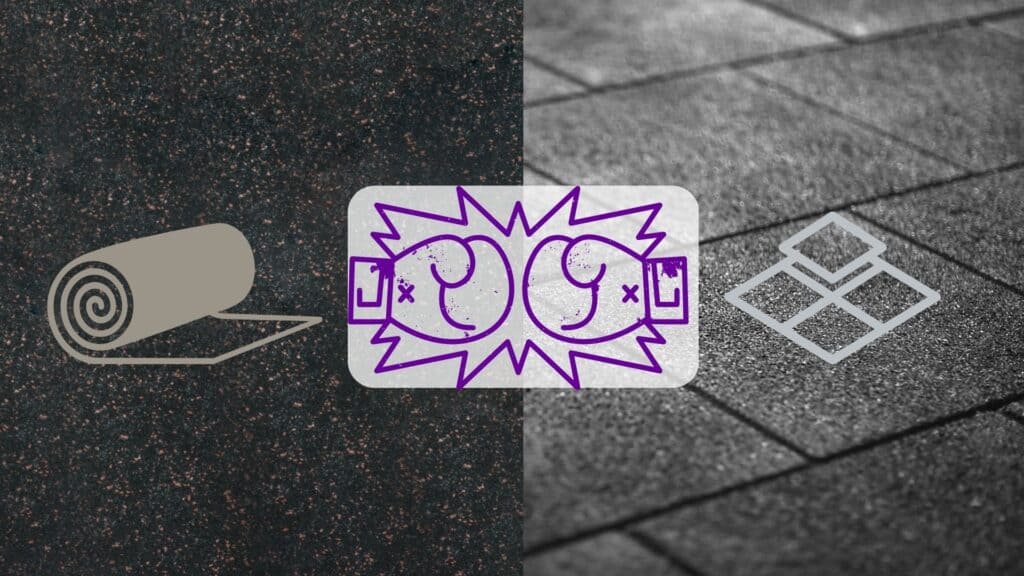Comparing Gym Flooring Rolls vs. Gym Flooring Tiles: Which Is Right for Your Fitness Space?
Rubber is among the most popular materials for sports surfaces. It provides primary benefits such as durability and good slip resistance while being eco-friendly and recyclable. Advantages established, it just remains to decide which format is appropriate to purchase: gym flooring rolls or tiles? How do they differ? What are the criteria for choosing?
The choice lies in which of the two options better meets your requirements, and comes down to adaptability and fit. The following information will guide you in making a useful assessment to decide which format best suits your specific needs. From good-to-know to the pros and cons of both formats, with the support of summary tables.
Rubber flooring: general characteristics and applications
Rubber flooring has a variety of applications, from playgrounds to hospitals, and overwhelmingly inside gyms and sports environments. If not of natural origin, they are formed from synthetic materials, and recycled from vehicle tires. Once the final structure is made, regardless of the form – roll, tile or mat – they present the characteristics unique to the material itself.
It is a durable type of flooring which can last up to 50 years, has non-slip properties, is ideal for wet areas, is highly durable, and requires low maintenance. In addition, among the common beneficial properties, we find versatility given the possibility of customisation of colours and designs.
Finally, among the common features, is the breadth of installation options, dependent on the type of format chosen. These include interlocking tiles, slabs and square-edge tiles, continuous and contiguous rolls, and mats that are more suitable for domestic use but may also be a fallback alternative for gyms.

Rubber gym flooring rolls: pros and cons
Rubber rolls are commonly available in the form of sheets measuring a minimum of four feet wide (1.2 metres) and a minimum length of fifteen feet (5 metres). They are available in different thicknesses to better suit specific needs and requirements. In fact, thin rolls are best suited for free-body exercises, medium-thick rolls are ideal for universal gyms, and thicker rolls are perfect for activities such as CrossFit, powerlifting and others that involve high impact.
Very inexpensive and extremely durable, they are best suited for high-traffic areas and large, busy spaces. Elegant to the eye, thanks to the absence of joints (in fact, if installed correctly, it is almost impossible to identify joining pieces), they can blend in perfectly with any theme of the sports facility. Standard-sized rolls are available with a black base but a custom design can be chosen if desired.
Summing up the pros of rubber rolls, they are:
- Ultra-durable
- Suitable for high-impact activities
- Easy to install in large spaces
- Securely mountable
- Elegant to the eye (no joints)
- Affordable
- Easy to maintain
Despite interesting and numerous advantages, rubber rolls also have some disadvantages, including:
- More difficult to install than interlocking rubber tiles (professional installation is highly recommended for optimal results )
- Heavy
- Slippery when wet
- Characterised by a strong odour, which tends to diminish over time
- Flammable. In fact, the adhesives used in the installation process are anything but fireproof (always check fire regulations in your region before opting for a surface material)
- Not UV-stable, especially if they are coloured rubber. Must be kept away from sunlight.
| PROS | CONS |
| Ultra-durable Suitable for high-impact activities Easy to install in large spaces Securely mountable Elegant to the eye (no joints) Affordable in terms of price Easy to maintain | Complicated to install in small spaces Heavy Slippery when wet Strong odour Flammable Not UV-stable, keep away from direct sunlight |
PROS – GYM FLOORING ROLLS
- Ultra-durable
- Suitable for high-impact activities
- Easy to install in large spaces
- Securely mountable
- Elegant to the eye (no joints)
- Affordable in terms of price
- Easy to maintain
CONS – GYM FLOORING ROLLS
- Complicated to install in small spaces
- Heavy
- Slippery when wet
- Strong odour
- Flammable
- Not UV-stable, keep away from direct sunlight
Rubber gym flooring tiles: pros and cons
Rubber tiles are the most popular type of flooring. They are available in squares with minimum dimensions of 30 cm x 30 cm. They can be cut into different shapes and sizes, allowing almost total customisation of the space, as well as complete freedom of layout regardless of the area. You can also create unique patterns and designs on the floor surface if desired.
Rubber tiles are extremely easy to install as they feature interlocking edges. Unlike rolls, there is no necessity for professional installation, let alone adhesives or glue. However, in the most high-traffic areas, it is possible to glue them together, to prevent them from separating and becoming a potential trip hazard. They are also easily and cheaply replaced should a piece become damaged, which in the case of rolls is less feasible.
The inherent advantages of rubber flooring tiles are:
- Resistant to workouts and heavy traffic
- Customisable (style, colours, layouts)
- Highly adaptable to space (they can be cut)
- Easy to install (no adhesives or professional staff required)
- Relatively lightweight
- Easily interchangeable in case of damage (only the affected piece, not the entire area)
- Easy to remove, store and reuse in another location
- Attractive to the eye
- Simple to clean
These countless advantages are balanced, however, by some disadvantages that you need to be aware of before defining your selection criteria.
The main disadvantages of rubber tiles include:
- Installation, although simple, is time-consuming, especially in large spaces
- Visible floor joints
- Due to the nature of the installation, it is possible for water to seep into the subfloor
- Smooth tiles become highly slippery when wet
- Strong odour from the material lingers for the first few months after installation
| PROS | CONS |
| Durable Customisable Highly adaptable to a space Easy to install Relatively lightweight Easily interchangeable Can be stored Beautiful to the eye Easy to clean | Installation is laborious in large spaces Visible seams Possible water seepage Highly slippery when wet Strong odour in the first few months |
PROS – GYM FLOORING TILES
- Durable
- Customisable
- Highly adaptable to a space
- Easy to install
- Relatively lightweight
- Easily interchangeable
- Can be stored
- Beautiful to the eye
- Easy to clean
CONS – GYM FLOORING TILES
- Installation is laborious in large spaces
- Visible seams
- Possible water seepage
- Highly slippery when wet
- Strong odour in first few months
Selection criteria – a table of comparison
In order to clarify the benefits and drawbacks of the two types of rubber flooring, it is good to keep in mind that there is no right or wrong. Both solutions should be considered according to your needs. The table below will help you weigh up the relevant criteria for your solution.
| CRITERIA | ROLLS | TILES |
| PRICE | Cheaper | More expensive |
| INSTALLATION | Big spaces | Medium-small spaces |
| RESISTANCE | Ultra strong | Resistant |
| CUSTOMIZATION | Colour, width and length | Easy to cut / design |
| REUSE | Difficult | Easy to store |
| AESTHETIC | No joints | Grid appearance |
| VERSATILITY | Moderate | Suitable for irregular areas |
| MAINTENANCE | Easy to clean | Easy to clean |
| STRONG ODORS | Early months | Early months |
| DANGER | Flammable | Not watertight |
Conclusion
You now have all the criteria at your disposal to evaluate the most useful and functional choice for you, based on your specific needs. However, if we want to give some general guidelines, rubber tiles lend themselves to rubber flooring for small spaces. They are easy to apply and versatile, as well as portable. Rubber rolls are the best option for permanent flooring for a larger space, where durability, longevity, and resistance to wear and tear are the predominant criteria.
To comment on the article, please proceed to the Telegram post. We encourage you to read our comprehensive article “How To Choose Gym Flooring“.
Disclaimer: The opinions and positions expressed in this publication are those of the authors and collaborators and do not necessarily reflect the views or policies of the professional fitness community.

